
Anne Baxter was an American actress, star of Hollywood films, Broadway productions, and television series. She won an Academy Award and a Golden Globe, and was nominated for an Emmy.
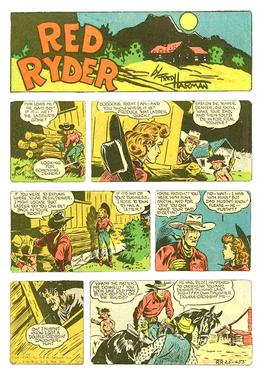
Red Ryder is a Western comic strip created by Stephen Slesinger and artist Fred Harman which served as the basis for a wide array of character merchandising. Syndicated by Newspaper Enterprise Association, the strip ran from Sunday, November 6, 1938, through 1965.
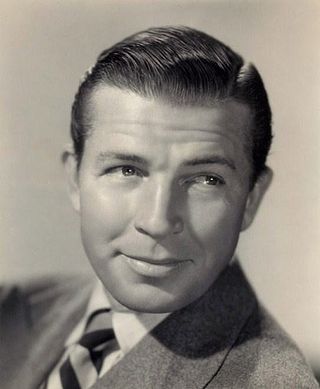
Bruce Cabot was an American film actor, best remembered as Jack Driscoll in King Kong (1933) and for his roles in films such as The Last of the Mohicans (1936), Fritz Lang's Fury (1936), and the Western Dodge City (1939). He was also known as one of "Wayne's Regulars", appearing in a number of John Wayne films beginning with Angel and the Badman (1947), and concluding with Big Jake (1971).

Tom Tyler was an American actor known for his leading roles in low-budget Western films in the silent and sound eras, and for his portrayal of superhero Captain Marvel in the 1941 serial film The Adventures of Captain Marvel. Tyler also played Kharis in 1940's The Mummy's Hand, a popular Universal Studios monster film.

Ride in the Whirlwind is a 1966 American Western film edited and directed by Monte Hellman and starring Cameron Mitchell, Millie Perkins, Jack Nicholson, and Harry Dean Stanton. Nicholson also wrote and co-produced the film with Hellman. A trio of cowboys are forced to become outlaws due to a case of mistaken identity by the local authorities.

Smoky the Cowhorse is a novel by Will James that was the winner of the 1927 Newbery Medal.
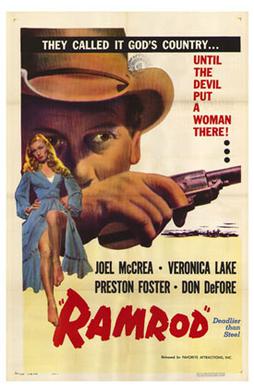
Ramrod is a 1947 American Western film directed by Andre de Toth and starring Joel McCrea, Veronica Lake, Preston Foster and Don DeFore. This cowboy drama from Hungarian director de Toth was the first of several films based on the stories of Western author Luke Short. De Toth's first Western is often compared to films noir released around the same time. Leading lady Veronica Lake was then married to director de Toth. The supporting cast features Donald Crisp, Charles Ruggles, Lloyd Bridges and Ray Teal.

The Plainsman is a 1936 American Western film directed by Cecil B. DeMille and starring Gary Cooper and Jean Arthur. The film presents a highly fictionalized account of the adventures and relationships between Wild Bill Hickok, Calamity Jane, Buffalo Bill Cody, and General George Custer, with a gun-runner named Lattimer as the main villain. The film is notorious for mixing timelines and even has an opening scene with Abraham Lincoln setting the stage for Hickok's adventures. Anthony Quinn has an early acting role as an Indian. A remake using the same title was released in 1966.

Fort Dobbs is a 1958 American Western film, the first of three directed by Gordon Douglas to star Clint Walker. The other two were: Yellowstone Kelly in 1959 and Gold of the Seven Saints in 1961.

The Bad Man of Brimstone is a 1937 American Western film directed by J. Walter Ruben and starring Wallace Beery, Virginia Bruce and Dennis O'Keefe. The screenplay was written by Cyril Hume and Richard Maibaum, from a story by Ruben and Maurice Rapf.

The Fargo Kid is a 1940 American Western film directed by Edward Killy starring Tim Holt. It was the second in Holt's series of Westerns for RKO. The film was shot in Kanab Canyon, Cave Lakes, and Johnson Canyon.

The Desperadoes is a 1943 American Western film directed by Charles Vidor and starring Randolph Scott, Claire Trevor, Glenn Ford, Evelyn Keyes and Edgar Buchanan. Based on a story by Max Brand, the film is about a wanted outlaw who arrives in town to rob a bank that has already been held up. His past and his friendship with the sheriff land them both in trouble. The Desperadoes was the first Columbia Pictures production to be released in Technicolor.

Best of the Badmen is a 1951 Western film directed by William D. Russell that is set in Breckenridge Missouri during the post-American Civil War period. It stars Robert Ryan, Claire Trevor and Robert Preston. It was a loose follow-up to Return of the Bad Men (1948).

One Desire is a 1955 Technicolor drama romance film directed by Jerry Hopper and starring Anne Baxter, Julie Adams and Rock Hudson. Described as a "rugged story of oil-boom Oklahoma in the early 1900s", it was adapted from Conrad Richter's best-selling 1942 novel Tacey Cromwell. Baxter portrays a gambling house owner, Hudson a card dealer turned bank president and Adams the woman who comes between them. A young Natalie Wood is also in a featured role.
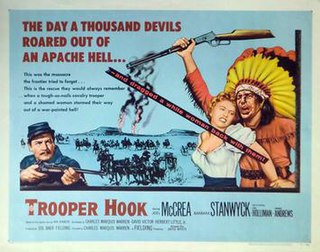
Trooper Hook is a 1957 American Western film directed by Charles Marquis Warren and starring Joel McCrea as the title character and Barbara Stanwyck as the woman he frees from the Indians. The fact that during her captivity she has had a son by a much-feared chief makes her situation very difficult.
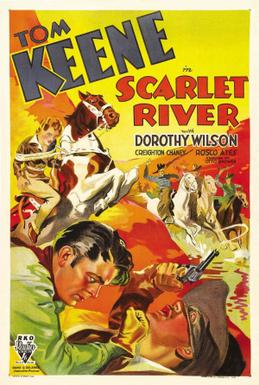
Scarlet River is a 1933 American pre-Code Western film directed by Otto Brower, written by Harold Shumate, and starring Tom Keene, Dorothy Wilson, Roscoe Ates, Lon Chaney Jr. and Edgar Kennedy. It was released on March 10, 1933, by RKO Pictures.

Smoky is a 1966 American Western film, directed by George Sherman and starring Fess Parker, Diana Hyland, Katy Jurado and Hoyt Axton. The third of three film adaptations of the 1926 novel Smoky the Cowhorse by Will James, it utilizes the screenplay from the 1946 film.
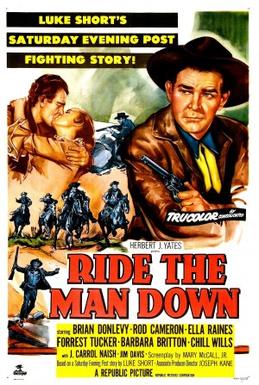
Ride the Man Down is a 1952 American Western film directed by Joseph Kane, written by Mary C. McCall, Jr., and starring Brian Donlevy, Rod Cameron, Ella Raines, Forrest Tucker, Barbara Britton, Chill Wills and J. Carrol Naish. The film was released on November 25, 1952, by Republic Pictures.

Overland Stagecoach is a 1942 American Western film directed by Sam Newfield and written by Fred Myton. The film stars Robert Livingston as the Lone Rider, Al St. John as his sidekick "Fuzzy" Jones, and Dennis Moore as Sheriff Smoky Moore, with Julie Duncan, Glenn Strange and Ted Adams. The film was released on October 11, 1942, by Producers Releasing Corporation.

Bison Film Company, also known as 101 Bison Film Company, was an American film studio established in 1909 and disestablished in 1917.




















